12 epic wildlife wonders to witness around the world


If you crave epic encounters with animals, these wildlife experiences will have you feeling full – heart and soul.
Come face to face with some of the world’s wildest creatures, from big tuskers in Kenya who need our protection to potentially undiscovered species of chameleon in Madagascar. You’ll never forget the sight of these wildlife wonders.
1. Big Tuskers, Tsavo East National Park, Kenya
Travelling with: Catherine Marshall
The hunt is over. We have found the big tusker after a days-long search. He sways ankle-deep in love grass, his jowls heavy with ivory. I snare him in my sights, aim the barrel lens, press the shutter. Then I lay my camera aside and lose myself in the majesty of the moment.

Have your binoculars ready on The Big Tusker Safari with Bench Africa.
Before me stands one of Tsavo Conservation Area’s eight remaining big tuskers – bull elephants whose tusks weigh in excess of 50 kilograms each and are so immense they often drag along the ground.
Brought to the brink of extinction by trophy hunters and ivory poachers, their genes have been identified in 27 younger members of the area’s 14,000-strong elephant population. Against such odds, the existence of these so-called “emerging tuskers” is miraculous.
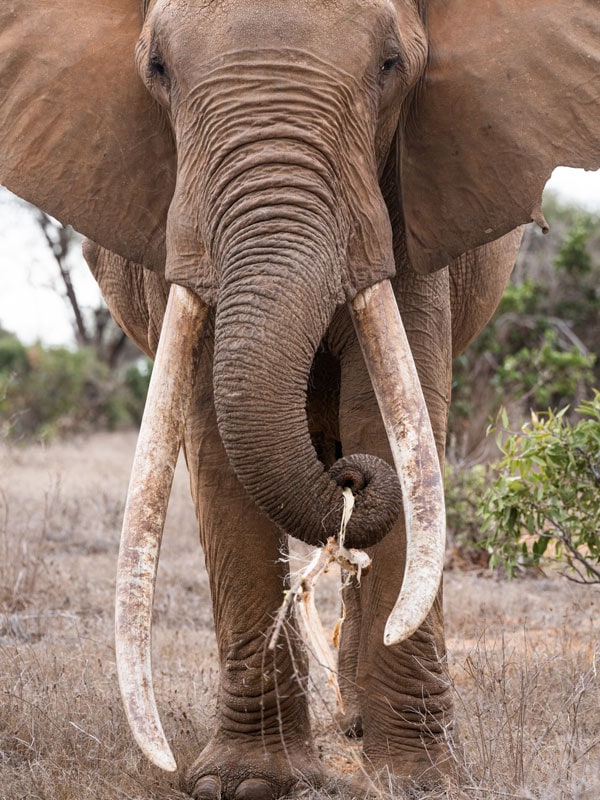
One of the big tuskers of Tsavo East National Park, Kenya. (Image: William Burrard-Lucas)
2. Rwanda Gorilla Naming Ceremony, Rwanda
Travelling with: Carla Grossetti
Even the most compelling Sir David Attenborough documentary cannot compare to the thrill of encountering mountain gorillas in the wild. The eco-diverse nation of Rwanda is home to about 1000 mountain gorillas and the great news is that number is slowly increasing.
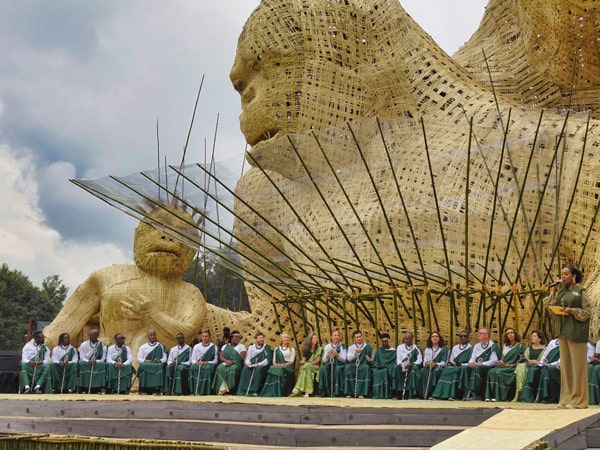
Meet Rwanda’s newborn baby gorillas at the naming ceremony.
Celebrate the success of conservation efforts by attending a naming ceremony for baby gorillas with Intrepid Travel on a Rwanda Gorilla Naming Ceremony & Uganda tour. In addition to sighting the magnificent creatures in Rwanda, the nine-day adventure includes a game drive in Uganda’s Queen Elizabeth National Park and cruise around Lake Kivu, one of the African Great Lakes. By taking a tour with Intrepid, you are directly supporting Gorilla Doctors, an organisation dedicated to caring for sick and injured mountain and eastern lowland gorillas in the wild.

Track mountain gorillas in Rwanda.
3. The Big Five, Ngorongoro Conservation Area, Tanzania
Travelling with: Sarah Reid
Like a giant fish bowl of wildlife, the jewel of northern Tanzania’s Ngorongoro Conservation Area is known for being populated with all the members of the Big Five (lion, leopard, rhino, elephant and buffalo), a pool full of hippo and even the odd cheetah.

A herd of gnus and wildebeests gather in Ngorongoro Crater National Park.
Hear the cackle of hyenas as your safari vehicle climbs down into the world’s largest intact volcanic caldera in the dawn mist, and ready your camera for non-stop action as you roll around this legendary ecosystem.

Spotting a lion in the wild is a thrilling experience.
4. Etosha National Park, Namibia
Travelling with: Sarah Reid
Ask any Africa safari specialist to name their favourite game parks and chances are Etosha will be high on their list. This seemingly harsh salt-encrusted desert landscape in northern Namibia teems with wildlife, popularly viewed at waterholes (some located conveniently close to campgrounds) that attract the park’s large elephant herds, black and critically endangered white rhinos, giraffes, zebras and various antelope species. Some 700 lions also roam this landscape, while elusive leopards slink through the darkness.

Etosha National Park is home to diverse wildlife species.
5. Makgadikgadi salt pans, Kalahari Desert, Botswana
Travelling with: Kee Foong
The desolate, barren Makgadikgadi salt pans in Botswana’s Kalahari Desert seem an unlikely magnet for wildlife. But a twist of nature makes it home to one of the largest migrations of zebra and wildebeest on the planet.
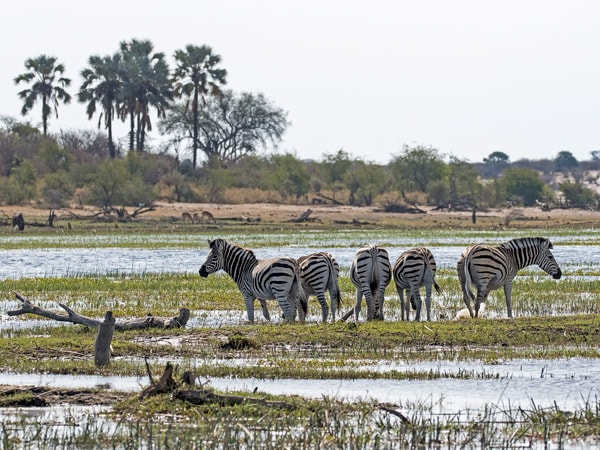
The zebra migration happens between the Boteti River and the Makgadikgadi Salt Pans.
To witness it, book into the luxe Jack’s Camp, with its ravishing Bedouin-style tents amid an oasis of palm trees, or its lower-key sibling San Camp, which rises like a shimmering mirage on the edge of the blinding white pans. The reserve is also home to desert-adapted lions and elephants, rare brown hyenas, aardvarks and adorable meerkats.

Sleep amongst the wilderness in San Camp in Botswana. (Image: David Crookes)
6. Snow leopards, Ulley Valley, Ladakh
Travelling with: Carla Grossetti
Trek through the folds of the Ulley Valley in Ladakh on a Snow Leopard Tracking Tour with Crooked Compass, which offers the chance to see the ‘ghosts of the mountain’ in their natural environment.

The cold doesn’t bother snow leopards in the Himalayas.
Expert trackers and guides will be on hand to point out the elusive animal and discuss conservation efforts dedicated to saving the species, known to roam in the high-altitude environment of northern India. The snow leopard is listed as a vulnerable species and a tour with Crooked Compass helps to safeguard their future.

Ulley Valley is the haven of snow leopards.
7. Chameleons, Madagascar
Travelling with: Sarah Reid
Between their ability to colour-morph and their long sticky tongue that can accelerate to 100 kilometres per hour in one-hundredth of a second, the humble chameleon is one captivating creature.
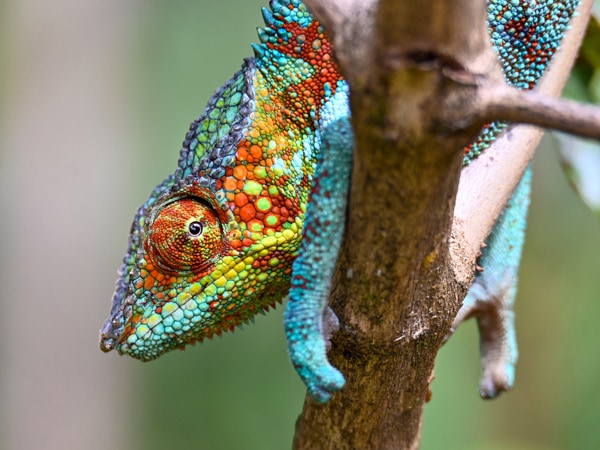
Panther chameleons are a sight to behold.
Home to about half of the world’s 150 chameleon species, Madagascar is the place to marvel at these incredible reptiles, which move a lot slower than their blisteringly fast tongue. With a new species discovered here in 2021, who knows how many more undiscovered specimens lurk in its tropical jungles.

The rugged landscape of Isalo National Park at dawn.
8. Komodo dragons, Komodo National Park, Indonesia
Travelling with: Kassia Byrnes
You’ll be given many warnings about Komodo dragons in Indonesia: don’t get too close, don’t stand in their line of sight, don’t have your period, don’t wander off alone. It’s enough to make you jittery that your guide is armed only with a forked wooden stick – until you spot one and their mighty size and almost mythical reputation leaves you in awe.
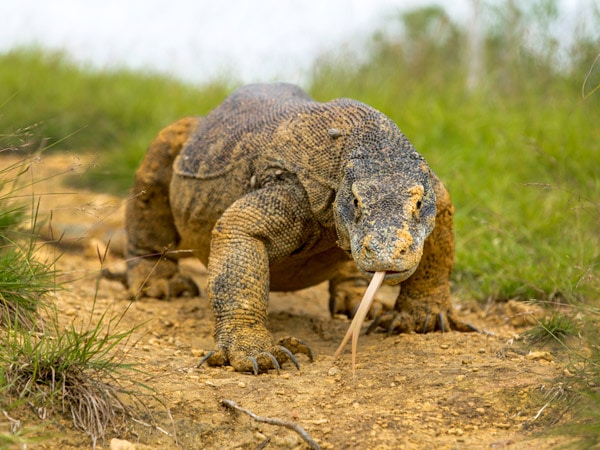
Indonesia is famous for its dragon lizards. (Image: Jerry Aurum)
Despite about 3156 dragons living in Komodo National Park, seeing one isn’t guaranteed. Go on a guided tour to increase your chances of spotting one of the most incredible animals roaming the planet today.

Pulau Padar Island lies within the Komodo National Park.
9. Lions, Masai Mara National Reserve, Kenya
Travelling with: Catherine Marshall
The alpha male strikes the first chord. His roar electrifies the bedrock, vibrates through the LandCruiser’s tyres, enters my body and almost shatters my bones. A second male joins in; the females soon add their baritones to the unearthly chorus.

Spot lions in Masai Mara National Reserve.
A sweet refrain arises from the cubs: they mewl at the unseen enemy, thinking they’re already grown. These kings of the jungle were once hunted by Masai boys as an initiation into manhood; today they are the Masai Mara National Reserve’s most cherished possessions.

A lion roars to mark his territory.
10. Polar bears and beluga whales, Manitoba, Canada
Travelling with: Katie Carlin
I am on a blue mat attached to a Zodiac floating in the middle of Hudson Bay with my head plunged under the icy-cold water when I come face-to-face with a smiling beluga whale. I yank my head out of the water on reflex. It’s a moment I’ve retold hundreds of times since and it never gets old.

Get an up-close encounter with beluga whales.
It can only be topped by Churchill’s other main attraction: polar bears. We spot one camouflaged in the tundra from the water, her nose pointed to the sky, sniffing. Her cub comes up beside her. The boat sways gently and we watch as she curls herself up to nurse. As a travel writer I am often asked the trip I’ve loved most – and this one tops my list.

The town of Churchill in Manitoba, Canada is the world’s polar bear capital.
11. Shark diving, Fakarava Atoll, Tahiti
Travelling with: Carla Grossetti
Take out your colour wheel and give it a spin to better calculate the hues, tints, tones and shades on show in the Lagoon of Fakarava. Fakarava means ‘beautiful’ in Tahitian, and the UNESCO Biosphere Reserve is the exact kind of tranquil beauty that the Islands of Tahiti are known for.

Diverse fish species inhabit the depths of Fakarava Lagoon. (Image: Frédérique Legrand)
Dive at the Fakarava Atoll in the late afternoon when the sun highlights its brilliant colours. The second largest in the Tuamotu Islands, the lagoon is a draw for divers who want to brave the ‘shark wall’, an annual phenomenon that sees hundreds of sharks converge at its southern edges to feed on an abundance of fish. It’s a spectacle like no other.

Embark to Fakarava Cruise Port. (Image: Alexandre Voyer)
12. The Bat Migration, Kasanka National Park, Zambia
Travelling with: Catherine Marshall
At daybreak, the sky above the swamp forest in Kasanka National Park, western Zambia, blackens with bats returning from a night’s foraging. The air throbs with their clamour; trees sag beneath the weight of their bodies. Come sunset, they will fly off again.
This is the world’s largest mammal migration, a spectacle that sees 10 million fruit bats from southern, western and equatorial Africa converge between October and December each year. Summoned by instinct (and wild fruit), the bats play an important conservation role: they help regenerate deforested tracts by dispersing seeds along their journey.
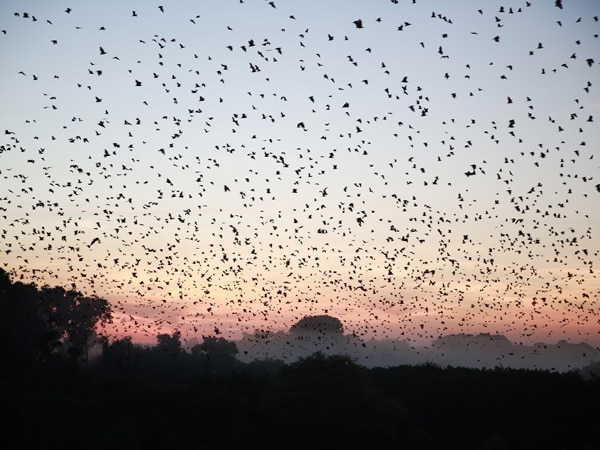
Millions of fruit bats converge upon Kasanka National Park. (Image: Catherine Marshall)












LEAVE YOUR COMMENT